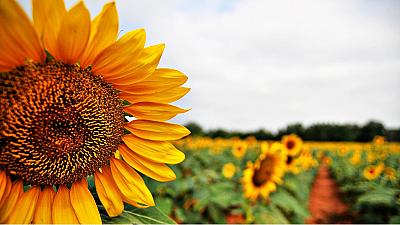What you need to know:
- In 2021, Kamau opened seven acres using the knowledge he picked from the demonstration farm. Within a short period of three months, Kamau harvested 5,013 kilogrammes of sunflower seeds and sold it to Mukwano at Shs1,500 per kilogramme. That season, Kamau earned Shs8m.
Nobert Kamau made Shs8m from his sunflower harvest in the second rainy season of last year.
It was his first time to plant sunflower in his 50 years of farming and his first time to make that much profit from any farming venture. And it was eye opening.
He had been a farmer since childhood, technically, because when you are raised in an agrarian culture, you get involved right away. You learn to hold a hoe before you know what it is.
As far as Kamau’s family is concerned, tobacco was the crop that was grown for cash in Bileafe Sub-county, Terego District in West Nile where Kamau comes from.
And when the tobacco market fell in the 2000s, cassava took its place as the cash crop. To make the most profit out of cassava, Kamau had formed a small farmers’ group with his friends to try and get a bigger voice in the market. But things were tough. “We were a group of serious cassava growers but we struggled to get market,” he says.
Turning point
Then in 2020, the DINU-LEWA project was launched in Bileafe. DINU-LEWA, which stands for Development Initiative for Northern Uganda and Livelihood Enhancement of West Nile and Acholi, is a project under the Prime Minister’s Office.
The project is ran by a consortium of three organisations; Lutheran World Federation (LWF), DanChurch Aid (DCA) and Mukwano Industries, with LWF as the lead.
The project, which was launched in 2020 in 10 districts is aimed at improving livelihoods of 56,000 small holder farmers, increasing agricultural productivity and marketing of key food and cash crops.
The project has introduced better methods of growing oil seeds such as sunflower and simsim to the communities and connected farmers such as Kamau to ready markets.
How he started
Kamau is almost euphoric about the transformation that growing sunflower has brought to him and his family. And he is only done this for one season.
“Our group got interested in growing the oil seed crops, sunflower particularly. To begin with, DINU-LEWA supported us with land opening of one acre for a demonstration farm. Our first harvest from the demonstration farm was 250 kilogrammes that we sold to Mukwano. We were all pleasantly surprised by the harvest and the ready market. We realised that the oil seed crops could generate good income if it was done on a larger scale,” Kamau says.
Benefits of farming sunflower
In 2021, Kamau opened seven acres using the knowledge he picked from the demonstration farm. Within a short period of three months, Kamau harvested 5,013 kilogrammes of sunflower seeds and sold it to Mukwano at Shs1,500 per kilogramme. That season, Kamau earned Shs8m.
“After selling the harvest, I was able to upgrade my home from the old grass thatched house into a two-roomed, iron-roofed brick house. I am currently building a bigger permanent home. I also bought several goats from that same money because we were advised to not just rely on crop production only,” he says.
Kamau’s next target
Kamau’s target this year is to produce at least 10,000 kilogrammes of sunflower. He is standing in one of his farms measuring about two acres near his home when Seeds of Gold arrived. This shamba is one of several that Kamau has just planted, totalling 15 acres. Kamau is confident that he will hit his 10,000 kilogramme target.
“The experts from the project trained us on sunflower agronomy. Now I can proudly say that I know how to grow sunflower, I know what kind of soil is suitable for sunflower, and I know how much seed I need for how much land,” Kamau says.
Sunflower agronomy
Sunflower production starts with seed and land acquisition, followed by land preparation (primary and secondary tillage). Planting is timed for the onset of seasonal rainfall. The hole for the seed cannot exceed a depth of 5cm and plant spacing of 75cms between rows and 25cms between plants is ideal. One seed per hole at seed rate of two kilogrammes per acre.
The first weeding normally takes place after a period of two weeks from the date of planting and second weeding during the vegetative growth stage.
Harvesting
Harvesting is normally done after the crop has attained physiological maturity of about 90 days when the heads have turned from green to yellowish to brown. Harvesting is done by cutting the head and placed on tarpaulins. This is followed by post-harvest handling activities that involves threshing, cleaning, drying, sorting, packaging and storage.
This is done when the crop has dried to the required moisture content of 10-13 percent. The last activity is marketing.


